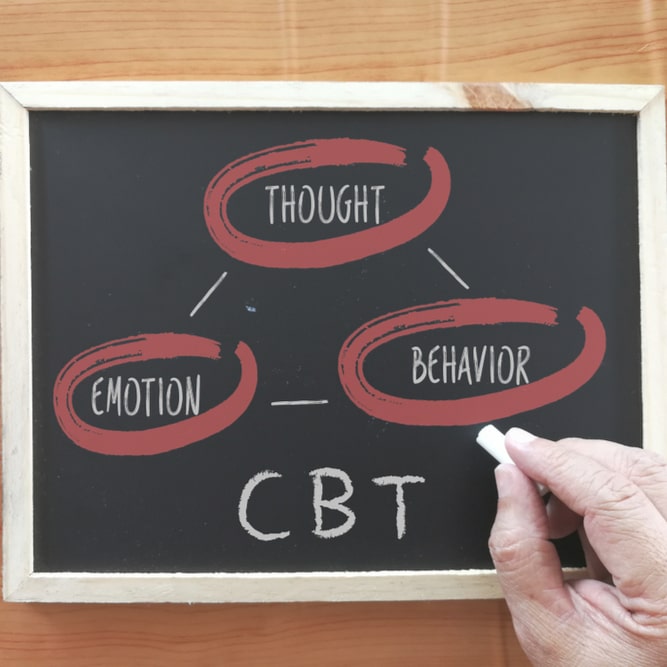Cognitive-Behavioral Therapy (CBT) is one of the most common types of psychotherapy treatments used in the world today. It’s designed to help individuals better identify their thought patterns. It can also be used to change disturbing and destructive thoughts that may lead to negative emotions and behavior.
The main premise of cognitive behavioral therapy is to change automatic negative decisions that could worsen or contribute to emotional issues, anxiety, and depression. The presence of these negative thoughts can cause someone to have a negative mood.
These negative thoughts are seen, challenged, and then replaced with more realistic and objective thoughts through CBT.
What CBT Can Assist With
CBT is often a short-term treatment option that helps you focus on your present beliefs and thoughts. It can be used to treat many conditions, such as:
- Addiction
- Anger problems
- Anxiety
- Bipolar disorder
- Depression
- Eating disorders
- Panic attacks
- Personality disorders
- Phobias
It can also help with serious illnesses, chronic pain, breakups or divorce, loss or grief, and low self-esteem. CBT can also be used in stress management or help with relationship problems.
Cognitive-behavioral therapy has been extensively studied and is effective for a wide range of mental conditions. Research has been so widespread because the therapy focuses on results and goals that can be easily measured.
Different Types of CBT
There are many approaches and techniques under CBT that help address behaviors, emotions, and thoughts. Some are structured under a Pasadena, CA, therapist, while others might be done on an individual at-home basis. Some of the different types of therapy that encompass CBT include:
- Cognitive Therapy – Focuses on identifying and modifying distorted or inaccurate thinking patterns, behaviors, and emotional responses.
- Dialectical Behavior Therapy – Deals with behaviors and thoughts through mindfulness and emotional regulation strategies.
- Multimodal Therapy – Works on the idea that seven interconnected parts must be addressed in therapy. These include biological considerations, interpersonal factors, drug considerations, cognition, imagery, sensation, affect, and behavior.
- Rational Emotive Behavior Therapy – Focuses on finding irrational beliefs, challenging each of them, and learning to recognize and alter those thought patterns.
All of these types of CBT have different approaches. However, each works to change negative thought patterns that may lead to psychological issues.
Techniques Used In CBT
Part of the process of CBT is identifying negative thought patterns. However, various strategies may be used to overcome unwanted thoughts. Techniques can include mental distractions, relaxation techniques, roleplaying, and journaling.
Recognizing Negative Thoughts
It’s essential to understand how feelings, thoughts, and situations are related to maladaptive behavior. This can be challenging, especially for less introspective people. However, it can lead to insights and self-discovery important to treatment.
Practicing Skills
Practicing new skills to use in the real world is also essential. For instance, someone who abuses substances might learn new skills and rehearse ways to handle or avoid situations that could lead to a relapse.
Setting Goals
Setting goals is important to help you make life and health changes that improve your mental state. A CBT therapist can help you learn skills to create goals, set SMART (specific, measurable, attainable, relevant, time-based) goals, and focus on the process and the outcome.
Problem Solving
Learning to solve problems is helpful to view and solve issues that come from life stresses, whether big or small. It can also help lessen the effects of physical or psychological illness. CBT problem solving often has five steps:
- Determining what a problem is
- Coming up with a list of potential solutions
- Weighing the weaknesses and strengths of the solutions
- Deciding which solution to move toward
- Implementing the chosen solution
Self-Monitoring
Self-monitoring, which means keeping a journal or diary, is another part of CBT. It gives you the chance to track experiences, symptoms, and behaviors over time so you can share them with your therapist in Pasadena, California. It can provide your therapist with essential information to create the best treatment plan.
For example, someone with an eating disorder can self-monitor by keeping track of what they are eating and what feelings and thoughts come with each meal or snack.
Cognitive Behavior Therapy in Pasadena, CA
If you are interested in exploring the benefits of cognitive-behavioral therapy, Alejandro Sandoval at SandovalTherapy is here to help. He has been practicing for over a decade and specializing in acculturation stress, transgenerational trauma, racial identity, relationship issues, etc.

